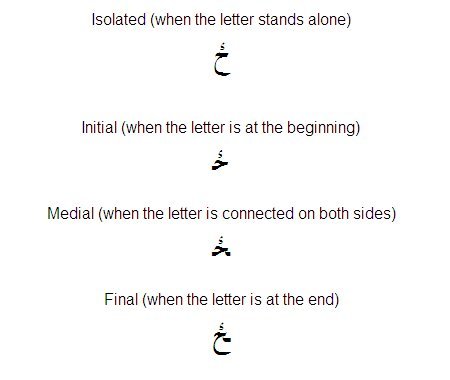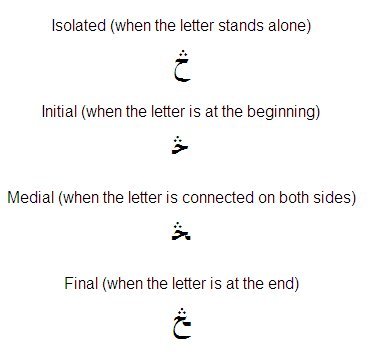Pashto Alphabet: Step III Posted by Transparent Language on May 26, 2010 in Basic, Pashto Alphabet
To continue where we left off last time, we’ll start with the next family of letters:
se: ث
Transliteration: s
“se” is the sixth letter in the Pashto alphabet. As with most Pashto letters, “se” is normally joined to the letters that precede and follow it. Therefore, “se” has four forms: isolated, initial, medial, and final.
Isolated (when the letter stands alone)
ث
Initial (when the letter is at the beginning)
ﺛ
Medial (when the letter is connected on both sides)
ﺜ
Final (when the letter is at the end)
ﺚ
“se” is part of a five-letter family, along with ب “be”, ت “te”, ټ “Te”, and پ “pe”. These five letters are very similar in form, except for the number and placement of the dots. ث “se” has three dots above. ب “be” has one dot below. ت “te” has two dots above. ټ “Te” has two dots above and a small circle below. پ “pe” has three dots below.
The three dots above the line of text are a good marker for spotting this letter. “shin” also shows three dots above the line, but has three spikes in its core medial form, compared to the single spike in “se”. Compare the medial form of ﺜ “se” with the medial form of ﺸ “shin”. The medial form of ﺜ “se” also resembles the medial forms of ﻨ “nun” and ﯿ “yaa-yi maruf”, but the number and placement of the dots is different.
The sound of the letter ث “se” is similar to the English letter “s” as in “sat.” There are two more letters in Pashto that have the same sound, س “sin” and ص “swaad”. Most words that contain these two letters are of Arabic origin.
jim: ج
Transliteration: j
This is probably the easiest letter to remember. “jim” looks like a reversed, italicized version of a capital J with a dot in the middle. The shape provides a very useful mnemonic trigger. “jim” is the seventh letter in the Pashto alphabet and assumes the following forms:
Isolated (when the letter stands alone)
ج
Initial (when the letter is at the beginning)
ﺟ
Medial (when the letter is connected on both sides)
ﺠ
Final (when the letter is at the end)
ﺞ
“jim” is part of a six-letter family, along with ح “he”, خ “khe”, چ “che”, څ “tse” and ڂ “dze”. These six letters are very similar in form, except for the placement of the dots. ج “jim” has one dot below the line (inside the looping flourish in those forms that have the flourish). ح “he” has no dot. خ “khe” has one dot above. چ “che” has three dots below the line (inside the looping flourish in those forms that have the flourish). څ “tse” has three dots above. ڂ “dze” has a symbol like a small lightning bolt above, although sometimes “hamza” is used instead of the lightning bolt ځ .
The single dot below the line of text is a good marker for spotting this letter. ب “be” also shows a single spike above the line and one dot below in its medial form, but the spike is differently shaped and more vertical. Compare the medial form of ﺠ “jim” with the medial form of ﺒ “be”.
The sound of ج “jim” is similar in pronunciation to the English sound “j” as in “jam”.
che: چ
Transliteration: ch
“che” is the eighth letter in the Pashto alphabet. As with most Pashto letters, “che” is normally joined to the letters that precede and follow it. Therefore, “che” has four forms: isolated, initial, medial, and final.
Isolated
چ
Initial
ﭼ
Medial
ﭽ
Final
ﭻ
dze: ڂ
“dze” is the ninth letter in the Pashto alphabet. You should start to see some patterns already with the shapes of these letters, as they are grouped in families. Here are the forms that “dze” assumes:

tse: څ
Our 10th letter also has standard forms. Notice how it is very similar to “dze” in shape. The main difference is that “tse” has three dots instead of a diacritical squiggle mark.

This concludes the first 10 letters of the Pashto alphabet. But let’s do one extra for kicks! This will help us get through the first two of the major families in the Pashto alphabet.
ح (he)
Transliteration: h
Isolated
ح
Initial
ﺣ
Medial
ﺤ
Final
ﺢ
You should now be familiar with the first two families of the Pashto alphabet:
- The first includes
ب “be” پ “pe”, ت “te”, ټ “Te”, ث “se”.
Do you see the similarities?
- The second includes:
ج “jim”, ح “he”, خ “khe”, چ “che”, څ “tse”, ڂ “dze”.
How about now? I hope this is starting to prove that learning a non-romance language isn’t that hard!

Build vocabulary, practice pronunciation, and more with Transparent Language Online. Available anytime, anywhere, on any device.
About the Author: Transparent Language
Transparent Language is a leading provider of best-practice language learning software for consumers, government agencies, educational institutions, and businesses. We want everyone to love learning language as much as we do, so we provide a large offering of free resources and social media communities to help you do just that!




Comments:
Sanasaif:
I enjoy your site, it is great for learning Pashto! I am learning to speak to my new in-laws, thank you so much!
I had the Byki download prior to finding your site. However, I would like to know where to download the card for the alphabet, other than the first 10 letters? That is the only one I have been able to find. Thank you for any help!
Keep up the great tutorials, it is finally making sense to me!
A tutorial on how to pronounce the difficult letters in Pashto that have no equivalent in English would be appreciated. I have not been able to find a good site where they show your mouth and where to place your tongue for each foreign letter or sound. Some are so difficult I am sure I will never get them! LOL